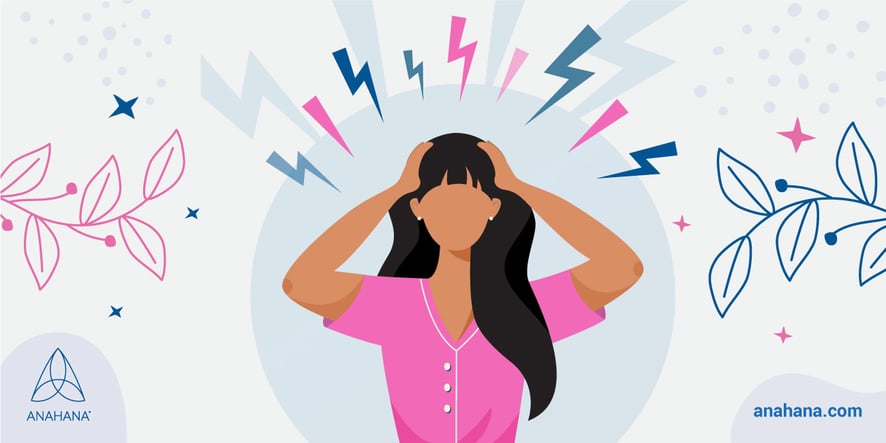
Table of Contents
Learn more about chronic migraines, a disorder that results in frequent recurring painful headaches. Understand the causes, symptoms, triggers, and what one can do to prevent or treat chronic migraines.
Key Takeaways
- Definition: Chronic migraines are frequent migraines defined as having fifteen or more headache days per month, with at least eight days showing migraine features over three months.
- Symptoms: Symptoms include severe headache pain, throbbing pain, sensitivity to light, nausea, vomiting, and aura symptoms.
- Causes: Triggers include stress, anxiety, certain foods, hormonal changes, and sleep disturbances.
- Diagnosis: Involves medical history, tracking headache days, and possibly MRI or CT scans.
- Treatment: Treat migraines with medications, painkillers, and complementary therapies.
- Management: Lifestyle changes, routine physical activity, stress management, and avoiding triggers can help treat chronic migraine.
What are Chronic Migraines?
Migraines are one of several headache disorders affecting 12% of the population worldwide. Migraines are the third highest cause of disability, according to the Global Burden of Disease Study in 2019.
Chronic migraines are diagnosed when a person experiences fifteen or more headache days each month, with a minimum of eight days of having migraine features for over three months.
Migraine attacks are known to become more severe and frequent as time goes on. Medical professionals classify these attacks into two types: episodic migraines and chronic migraines.
While episodic migraines occur infrequently, chronic migraines repeatedly occur over at least three months.
Episodic migraines have the potential to develop into chronic migraines over time. Studies have shown that around 3% of individuals who experience episodic migraines progress to develop chronic migraines.
Chronic Migraine Symptoms
Although the symptoms of episodic and chronic migraines are the same, the frequency and intensity of the symptoms vary.
Common symptoms of all migraines include:
- moderate to severe pain
- severe throbbing pain on one or both sides of the head
- pulsating sensation and pressure-like pain
- worsening pain with movement/physical activity
- extreme sensitivity to sound, light, nausea
- and vomiting accompanying the head pain.
Chronic Migraine Causes
Individuals who experience migraines may find that certain factors, such as specific environments, situations, and behaviors, will trigger a new migraine episode. These are commonly called migraine triggers.
Some common triggers for people with chronic migraine include:
- anxiety and stress
- excessive caffeine consumption
- specific foods and drinks
- medications
- weather changes
- sensory stimulation
- hormone changes
- and ongoing sleep disturbances.
Triggers can vary based on an individual; therefore, people with chronic migraine may benefit from identifying and keeping track of their triggers in a migraine diary.
This way, individuals can try to reduce their exposure to common triggers.
Anxiety and Stress
Individuals with a migraine history might experience episodes of higher anxiety and stress.
High levels of stress and anxiety release the hormone cortisol, which can result in vascular changes in the brain, resulting in inflammation and chronic headaches.
Stress-related experiences or environments causing stress lead to behavioral changes and symptoms in individuals, including inadequate sleep, muscle tension, eating fewer meals, or forgetting to take medications.
Excessive Caffeine Consumption
Overconsumption of caffeine is another common migraine trigger. Caffeine is a stimulant that can potentially trigger an episode of migraine.
Drinks or high-sugar sodas containing caffeine can also contribute to a migraine headache.
Specific Foods and Drinks
Certain artificial sweeteners, spicy, salt, and aged foods (cheeses and cured meats) can trigger migraines. Monosodium glutamate (MSG) is a food preservative that can trigger migraine headaches.
Managing diet and meal plans is also essential, as skipping meals can trigger headaches in some people with chronic migraine.
Hormonal Changes
Chronic and episodic migraines are more common in women than in men.
For example, hormone changes during menstruation, before and after menopause, and hormonal medications can trigger migraine headaches.
Medications
Overuse of migraine medications or vasodilators that can affect the vascular system or blood vessels can trigger migraines or worsen an episodic migraine.
Individuals who take migraine medications may also experience rebound migraines.
It is best to contact healthcare providers regarding migraine medication use. Overuse of migraine medications can occasionally result in a medication overuse headaches.
Weather Patterns
Changes in seasonal and weather patterns can also alter the status of migraine.
Shifts in barometric pressure, humidity, and temperature can also influence the time, severity, and frequency of migraine headaches.
Sensory Stimulation
Sensory stimulations, including strong odors, loud music, and flashing lights, can also trigger episodes of migraine headaches in individuals.
Sleep Disturbances
Sleeping seven to eight hours each night is crucial to prevent migraines. Not getting adequate sleep or getting too much sleep can worsen a migraine attack.
How is a Chronic Migraine Diagnosed?
If individuals believe they are experiencing chronic migraines, they should contact a healthcare provider.
A healthcare professional or headache specialist will take a detailed medical history and assess the individual’s symptoms and possible triggers.
The doctor might ask individuals about their patterns of migraine pain, whether they are continuous or episodic, the intensity and frequency of the migraines, and any identified risk factors or triggers.
Tracking headache days using a headache journal is crucial for a diagnosis, as the diagnosis will depend on the number of headache days an individual has.
They will also gather information about family history, the pain's severity, sensation, location, other symptoms accompanying the pain, current and previous medications, and lifestyle factors that might be causing secondary headaches.
A headache specialist can conduct a neurological examination or diagnostic criteria to rule out other types of chronic headaches.
MRI or CT scanning
Chronic Migraines can also be diagnosed using an MRI or CT scan.
MRI scans use radio waves and a magnetic field to produce images of blood vessels and the brain, helping healthcare professionals diagnose neurological conditions and brain disorders, including migraines.
CT scans use X-rays to generate cross-sectional brain images, helping doctors diagnose brain damage, infections, tumors, or possible medical issues that might cause headaches in individuals.
Prevention of Chronic Migraine

Chronic migraine treatment focuses on managing lifestyle choices, triggers, and preventive treatments. Some lifestyle changes that can improve chronic migraines include:
- routine physical activity
- relaxation
- stress management
- hydration
- and a balanced diet
Preventive Medications
Preventive medications aim to reduce headaches' severity and frequency, including angiotensin blockers, beta-blockers, tricyclic antidepressants, calcitonin gene-related peptides (CGRP), and toxin A botox injections.
Botox injection treatment was the first preventive treatment approved by the Food and Drug Administration (FDA) and is shown to be effective in reducing the frequency of migraines.
Alternative Medicine
According to the American Migraine Foundation, dietary or food supplements, also called nutraceuticals, can help individuals relieve migraine symptoms.
Some common herbal supplements that can help with migraine include vitamins such as vitamin B2 (riboflavin), magnesium, feverfew, melatonin, and coenzyme Q10 (CoQ10).
Individuals with chronic migraine might have low levels of minerals and vitamins. Therefore, supplementation is useful.
In people with normal levels of vitamins and minerals, herbal supplements can still reduce the frequency and intensity of migraines at specific doses.
Yoga for Migraine
Yoga involves mind-body poses, breathing, and meditation that can help relieve stress, a common cause or trigger of migraine headaches.
Not everyone might be familiar with yoga; therefore, getting help from a yoga teacher or joining a yoga class might be an excellent first step to getting acquainted with yoga and finding postures suitable for their migraines.
Intense or difficult postures might trigger migraines in individuals, especially beginners.
Therefore, discussing migraine triggers with one's instructor, including music and scented candles, is essential.
Finding forms of yoga involving deep meditation and breathing is particularly useful for individuals with migraine.
Some of these include:
- hatha yoga
- restorative yoga
- elbow bends
- shoulder rotations
- neck rotations
- neck bend
- and wrist rotations
Healthy Lifestyle Habits
Lifestyle habits and choices can reduce the frequency and intensity of migraine headaches.
Some healthy lifestyle habits include finding a calm environment, establishing a sleep schedule, eating balanced meals and avoiding foods that trigger headaches, exercising regularly, and managing stress.
Stress management involves doing activities one enjoys, finding time to relax, spending time with friends and family, and striving for balance.
Treatment of Chronic Migraines
Treatment for chronic migraines is similar to episodic migraines, with a few differences.
Treating a chronic migraine may include medications and painkillers, slowly increasing them in dose, and complementary therapies, including transcranial magnetic stimulation and transcutaneous supraorbital nerve stimulation.
Early treatment of episodic migraines can reduce the likelihood of an individual with episodic migraines transitioning into chronic migraines, and individualized treatment can also revert chronic migraines to episodic migraines.
Acute Treatments
Acute treatments for migraine attacks include acute migraine medications, prescription treatment, and over-the-counter medications, including acetaminophen, ibuprofen, and sumatriptan.
However, limiting medication use to avoid overuse symptoms is critical.
Conclusion
The goal for individuals with chronic migraine is to control the headaches. Preventing and managing a chronic migraine with a suitable treatment plan is possible.
Reducing the severity and number of headaches can help individuals with chronic migraine and revert them to an episodic one.
If an individual is experiencing a severe headache following chronic migraine symptoms, it is critical to see a doctor or healthcare provider.
Chronic migraines can negatively impact an individual's life, affecting areas such as school, work, and relationships with family and friends. Therefore, it is crucial to treat chronic migraines early.
References
Chronic Migraines: What You Need to Know
Understanding Chronic Migraines
Alternative Treatments for Migraine
Disclaimer
The contents of this article are provided for informational purposes only and are not intended to substitute for professional medical advice, diagnosis, or treatment. It is always recommended to consult with a qualified healthcare provider before making any health-related changes or if you have any questions or concerns about your health. Anahana is not liable for any errors, omissions, or consequences that may occur from using the information provided.

By: Anahana
The Anahana team of researchers, writers, topic experts, and computer scientists come together worldwide to create educational and practical wellbeing articles, courses, and technology. Experienced professionals in mental and physical health, meditation, yoga, pilates, and many other fields collaborate to make complex topics easy to understand. Anahana is also home to specialists in crystals, tarot, angel numbers, astrology, life path numbers, zodiac signs, and horoscopes. By combining evidence-based wellness with spiritual and energetic practices, the team offers clear, trustworthy guidance for both mind-body health and modern spirituality.